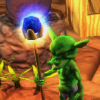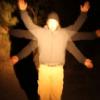Thanks JT.
I spent some of last night painting in art rage, exporting as png then Reloading in blender. That works well. My painting is pretty suck worthy, so I guess thats the root cause of my problem. I need to get better at painting.
Texture creation methods
My typical workflow is like this:
*Create the mesh I will use in game, at the necessary resolution.
*UV map it.
*Duplicate the mesh and set dup aside.
*Select other copy, add Sub-surf modifer and crank up the levels (or, if more appropriate, such as for architectural shapes, just enter Edit mode, select all verts, and subdivide the hell out of it.) I'm looking for a nice, dense mesh here.
*Enter Sculpt mode, and start doing surface detail. Wrinkles, ridges, folds, creases, etc... The denser your mesh, the better the results you get at this step.
*Create a new image assigned to the object, and enter Texture Paint mode. Grab a brush, and start globbing on color.
* Bake 3 renderings from the Render->Bake tab: Ambient occlusion, full render (with a white material, for the lightmap) and Texture only (with the painted on colors). Save each bake for import into Gimp.
* Import the bakes into Gimp, and do some editing. The color map might need tweaked, the contrast/brightness settings of the AO and lightmaps might need tweaked, etc...
* Import the new texture(s) back into Blender, and apply them to the low-resolution dup you made earlier.
* Test render, and see what it looks like. Repeat ad nauseum.
During the Texture paint stage, you can also import images that have a type of surface texture that you want. The latest version of Blender allows for painting from a Clone tool, rather than just solid colors.
When I do have to hand paint, the way I like to do it is in stages. The first stage, I don't worry about color. I worry about shading. I grab black and white brushes, and lay down areas, starting large and working down to finer and finer detail, making liberal use of blurring and smudging. It takes practice. Lots of practice. Once I have the value component map, I work on hue and saturation. Starting with hues, I lay down areas of color on another layer (with the value layer set to multiply so I can check shading). I adjust saturation as I go, tweaking and iterating over and over. I get fairly good results, but only with lots of effort.
*Create the mesh I will use in game, at the necessary resolution.
*UV map it.
*Duplicate the mesh and set dup aside.
*Select other copy, add Sub-surf modifer and crank up the levels (or, if more appropriate, such as for architectural shapes, just enter Edit mode, select all verts, and subdivide the hell out of it.) I'm looking for a nice, dense mesh here.
*Enter Sculpt mode, and start doing surface detail. Wrinkles, ridges, folds, creases, etc... The denser your mesh, the better the results you get at this step.
*Create a new image assigned to the object, and enter Texture Paint mode. Grab a brush, and start globbing on color.
* Bake 3 renderings from the Render->Bake tab: Ambient occlusion, full render (with a white material, for the lightmap) and Texture only (with the painted on colors). Save each bake for import into Gimp.
* Import the bakes into Gimp, and do some editing. The color map might need tweaked, the contrast/brightness settings of the AO and lightmaps might need tweaked, etc...
* Import the new texture(s) back into Blender, and apply them to the low-resolution dup you made earlier.
* Test render, and see what it looks like. Repeat ad nauseum.
During the Texture paint stage, you can also import images that have a type of surface texture that you want. The latest version of Blender allows for painting from a Clone tool, rather than just solid colors.
When I do have to hand paint, the way I like to do it is in stages. The first stage, I don't worry about color. I worry about shading. I grab black and white brushes, and lay down areas, starting large and working down to finer and finer detail, making liberal use of blurring and smudging. It takes practice. Lots of practice. Once I have the value component map, I work on hue and saturation. Starting with hues, I lay down areas of color on another layer (with the value layer set to multiply so I can check shading). I adjust saturation as I go, tweaking and iterating over and over. I get fairly good results, but only with lots of effort.
This topic is closed to new replies.
Advertisement
Popular Topics
Advertisement
Recommended Tutorials
Advertisement






